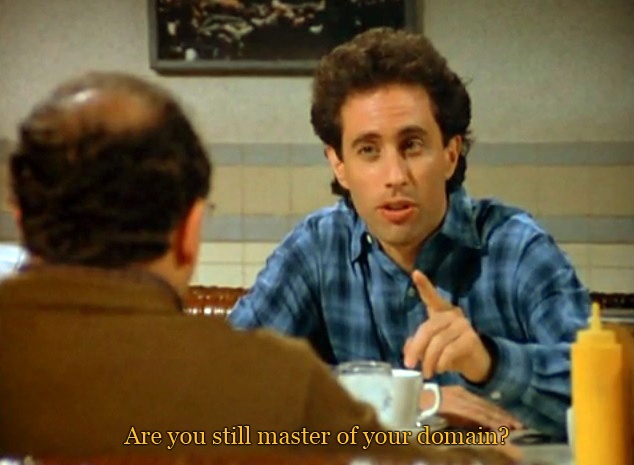
Suddenly you realize you’re unable to move forward with your awesome new website plans. Someone else owns and controls your domain name. Are you still master of your domain?
This frustrating scenario usually occurs when businesses are excitedly preparing to upgrade, refresh, or move their website. In many cases it happens to great start-up businesses who chose a do-it-yourself (DIY) website wizard, and took great pains to design “forever ago” as their free, starter site – just to get them going.
For a new website, sometimes a DIY vendor, webmaster, or other unknown person/friend/colleague owns and has complete control over a client’s domain name assets, unbeknownst to them, so we start by working together on correcting domain name contact records.
Let’s check now.
The WHOIS database is a searchable list of every single domain currently registered in the world. Several tools are available online to audit your domain name information. Below are four of the most popular WHOIS database lookup websites. You can check and verify your domain name contact details using one of these tools to make sure they are correct.
If contact details are not immediately available, look for and follow the link shown on your WHOIS results page to your specific registrar of record.
If your contact details are correct, great! Now make sure you have your username and password and are able to login and manage it.
Best practices for registering and protecting your domain name
It doesn’t matter if you register a domain name yourself, or if your web host, web developer, or someone else does it for you. What matters is that you, the small business owner, are listed as the domain owner and main contact person, AND that you are able to login and manage your account.
- Make sure you register your domain name using your name and contact information, in your own separate account – not a vendors’ bulk account. Use a reputable domain name registrar, and keep your username and password in a safe place. (Sometimes, even if your domain name is in your name, you cannot access it because you do not have the username and password to your web vendors account.)
- Beware of “do-it-yourself” website plus hosting vendors who ask you to provide OR register your domain name as a part of their step-by-step setup. Many DIY website vendors automatically take ownership of your domain name as a part of the setup process without alerting you! TIP: Be sure to check with your DIY website vendor about their domain name ownership policies, usually found in their Terms Of Use page, if you opt for a do-it-yourself website plan.
- Use an email address, such as Gmail, for your contact email address and check it frequently for notices from your registrar. Do not use an email address associated with the domain name itself (in case your website goes down or you wish to transfer your domain name).
Understanding your contact information
When registering a domain, there are a few contact information areas to understand:
- Registrant: The registrant is the legal owner of the domain. This should always be you, the business owner, not your web developer or anyone else.
- Administrative Contact: Whoever is listed here has the ability to change and transfer the domain name. This should be the business owner, or other trusted employee of your business. If your hosting company or web developer is listed here, they could easily claim ownership of the domain name or otherwise modify the records.
- Technical Contact: This contact is in charge of dealing with any technical problems with the domain. If you have a system administrator or some kind of IT person on staff, it could be him or her. But this is also the one contact where it’s a good idea to have your web hosting company listed.
How to be “Queen of the Castle”
Correcting domain name ownership can become very time consuming and sometimes impossible without legal action. The person or entity that owns your domain name also has the power to take down your website!
Make sure you are listed as both the Registrant and the Administrative Contact on your domain record. Always make sure you have an accessible and secure external email address tied to all of your domain names. If you find you’re not listed correctly, update your records right away or contact us for help.
It’s a huge relief to know you have control and ownership of your domain name. You’ll gain security, peace of mind, and the freedom to move your business forward with a reputable web developer and/or hosting company as it suits your online business success!
Cheers!
 Stacy Layman
Stacy Layman
Director, eCommerce Development
Jacksonville, Florida
